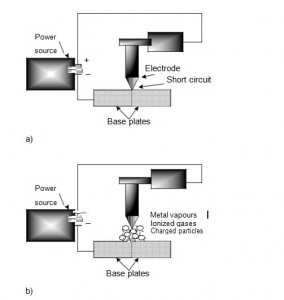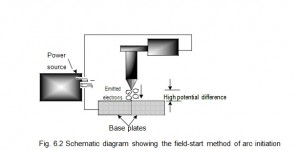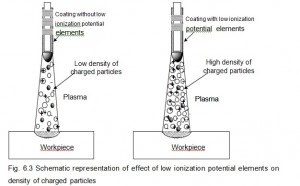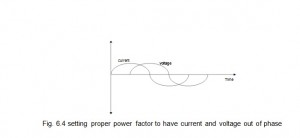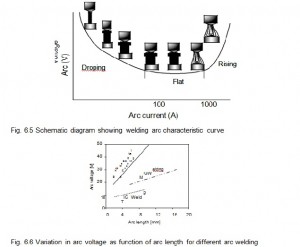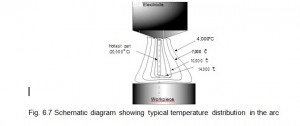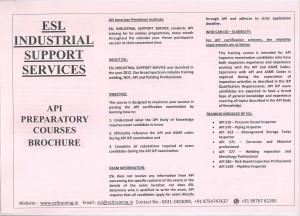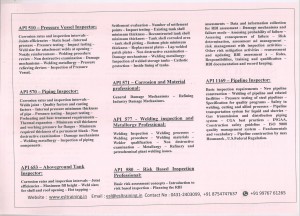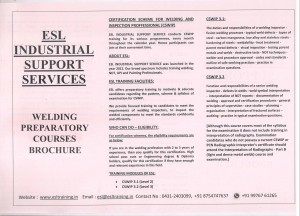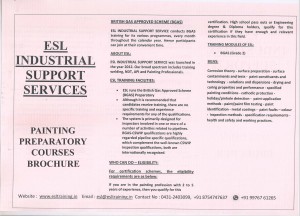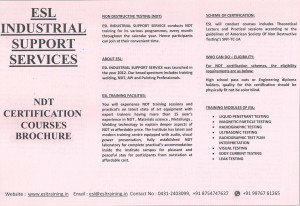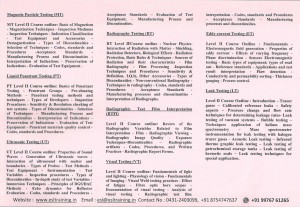HOW TO DO WELDING
Physics of Welding Arc II
In this How to do welding chapter, we dealt with the methods of initiating and maintenance of the welding arc besides the arc characteristics and temperature distribution in welding arc. Further, factors affecting the arc characteristics and temperature distribution of welding arc have also been described.
Keywords: Arc initiation, touch start, field start, ionization potential, power factor, arc characteristics, arc temperature
- Arc Initiation
There are two most commonly used methods to initiate an electric arc in welding processes namely touch start and field start. The touch start method is used in case of all common welding processes while the later one is preferred in case of automatic welding operations and in the processes where electrode has tendency to form inclusion in the weld metal like in TIG welding or electrode remains inside the nozzle.
HOW TO DO WELDING
6.1.1 Touch Start
In this method, the electrode is brought in contact with the work piece and then pulled apart to create a very small gap. Touching of the electrode to the workpiece causes short-circuiting resulting in flow of heavy current which in turn leads to heating, partial melting and even slight evaporation of the metal at the electrode tip. All these events happen in very short time usually within few seconds (Fig. 6.1 a, b). Heating of electrode produces few free electrons due to thermal ionization; additionally dissociation of metal vaporous (owing to lower ionization potential of the metal vapours than the atmospheric gases) also produces charged particles (electron and positively charged ions). On pulling up of the electrode apart from the work piece, flow of current starts through these charged particles and for a moment arc is developed. To use the heat of electric arc for welding purpose it is necessary that after initiation of arc it must be maintained and stabilized.
Fig. 6.1 Schematic diagram showing mechanism of arc initiation by touch start method a) when circuit closed by touching electrode with work piece b) emission of electrode on putting them apart
6.1.2 Field Start
In this method, high strength electric field (107 V) is applied between electrode and work piece so that electrons are released from cathode electro-magnetic field emission (Fig. 6.2). Development of high strength field leads to ejection of electron from cathode spots. Once the free electrons are available in arc gap, normal potential difference between electrode and work piece ensures flow of charged particles to maintain a welding arc. This method is commonly used in mechanized welding processes such as plasma arc and GTAW process where direct contact between electrode and work piece is not preferred.
- Maintenance of Arc
Once electric arc is initiated, next step is to maintain it to use the heat generated for welding purpose. For maintaining of the arc two conditions must be fulfilled (1) heat dissipation rate from the arc, region should be equal to that of heat generated to maintain the temperature of the arc and (2) number of electrons produced should be equal to that of electrons lost to the work piece and surroundings.
An electric arc primarily involves flow of current through the gap between the work piece and electrode hence there must be sufficient number of charged particles namely electrons and ions. However, some of the electrons are lost from the arc surface, to the weld pool and surroundings and few electrons reunite with ions. Loss of these electrons must be compensated by generation of new free electrons. In case of direct current, magnitude and direction of current does not change with time hence maintaining the flow of electrons and so the arc becomes easy while in case of alternating current (A. C.) both magnitude and direction change with time and for a moment flow of current becomes zero. This makes re-ignition of an electric arc with AC somewhat difficult and therefore it needs extra precautions and provisions. There are two commonly used methods for maintaining the arc in A.C. welding: (1) use of low ionization potential elements in coatings flux and (b) use of low power factor power source.
HOW TO DO WELDING
CHARACTERISTICS:
6.2.1 Low Ionization Potential Elements
In this method, low ionization potential elements such as potassium, calcium and sodium are added in the flux covering of the electrode (coating). These elements release free electrons needed to have reasonably good electrical conductivity for maintaining welding arc even with small potential difference between electrode and work piece (Fig. 6.3).
6.2.2 Low Power Factor
Power factor of a system indicates how effectively power is being utilized and it is generally preferred to have high power factor of machine or system. Power factor is defined as ratio of actual power drawn from the power source to perform the welding and apparent power drawn into the welding circuit line. Welding transformer operates at high power factor (>0.9).
However, in welding usually low power factor is intentionally used to improve the arc stability and maintenance of welding arc. In this method, current and voltage are made out of phase by using proper low power factor (0.3) so that when current is zero, full open circuit voltage is available between electrode and work piece (Fig. 6.4). Full open circuit voltage across the electrode and work helps in release of free electrons to maintain flow of already existing electrons which is a perquisite for maintenance of the arc.
- Arc Characteristic
Welding arc characteristic shows variation in the arc voltage with welding current. There are three different regions on the arc characteristic curve namely dropping, flat and rising characteristics zones (Fig. 6.5). Initially at low current when arc is thin, an increase in welding current increases the temperature of arc zone which in turn enhances the number of charged particles in plasma zone of the arc due to thermal ionization and thermo-ionic emission of electrons. As a result, electrical conductivity of arc zone increases which in turn decrease arc voltage decreases with initial increase in welding current in this zone. Arc tends to be stable in this region. This trend continues up to certain level of current and beyond that increase in current increases the diameter of cylindrical arc that increases the surface area of the arc. Increase in surface area of the arc in turn increases loss of heat from the arc surface. Therefore, no significant rise in arc temperature takes place with increase of current hence arc voltage is not affected appreciably over a range of current in flat zone of the curve. Further, increase in current bulges the arc, which in turn increases the resistance to flow of current (due to increased losses of charge carriers and heat from arc) so arc voltage increases with increase in welding current in rising characteristic zone . These three zones of arc characteristic curve are called drooping, flat and rising characteristics. Increase in arc length in general increases arc voltage during welding. However, the extent of increase in arc voltage with increase in arc length varies with process as shown in Fig. 6.6. In general, arc voltage increases almost lineally with increase in arc length (within reasonable limits) and the same is attributed to increase in resistance to the flow of current due to reduction in charged particle density in arc zones with increase in arc length.
Variation in charged particle density in arc zones associated different arc welding processes such as SMAW, GMAW and GTAW is attributed to appreciable difference in arc voltage vs. arc length relationship (Fig. 6.6). For example, GTAW process due to tungsten electrode (having high electron emitting capability) results in higher charged particle density in arc region than GMAW and SMAW which in turn leads to lower arc voltage/arc length ratio for GTAW than LMAW & SMAW process.
Temperature of the Arc
In addition to arc voltage and current parameters (governing the power of arc), thermal properties (thermal conductivity) of shielding gases present in arc zone predominantly affect the temperature and its distribution in the arc region. Thermal conductivity of most of the gases (He, N, Ar) increases with rise in temperature
however, this increase is not continuous for some of the gases such as Helium. Thermal conductivity of base metal/shielding gas governs temperature gradient in the arc region. Reduction in thermal conductivity increases the temperature gradient. Therefore, a very rapid decrease in temperature of arc is observed with increase in distance from the axis (center) of the arc (Fig. 6.7). Maximum temperature is observed at core (along the axis of electrode) of the arc and it decreases rapidly with increase in distance away from the core. Temperatures in anode and cathode drop zones are generally lower than the plasma region due to cooling effect of electrode/work piece. Temperature of arc can vary from 5000-30,000K depending upon the current voltage shielding gas and plasma gas. For example, in case of SMAW, temperature of arc is about 6000K while that for TIG/MIG welding arc it is found in range of 20000-25000K.
References and Books for further reading
Richard Little, Welding and Welding Technology, McGraw Hill, 2001, 1st edition.
H Cary, Welding Technology, Prentice Hall, 1988, 2nd edition.
S V Nadkarni, Modern Arc Welding Technology, Ador Welding Limited, 2010, New Delhi.
Welding handbook, American Welding Society, 1987, 8th edition, volume 1 & 2, USA.
————————————————————————————————————————————————————————-
This is how welding is done and we deal about it in next chapter of HOW TO DO WELDING


